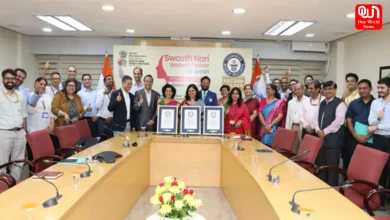Aditya-L1 Launch: Aditya-L1 is on its way to observe solar activities!
India's first solar observatory in space, Aditya-L1, has been successfully launched from Sriharikota and is now on its way to Lagrange Point 1 for four months. Monitoring solar activity and space weather is the goal of seven payloads.
Aditya-L1 Launch: India’s Historic Launch to Study the Sun!
On Saturday at 11:50, ISRO successfully launched its first space-based solar observatory mission, just days after India made history by becoming the first to land near the Moon’s south pole. Aditya-L1 lifted off from the launch pad at Satish Dhawan Space Centre in Sriharikota on a four-month-long journey to its destination, Lagrange Point 1.
Read more:- India’s Aditya-L1 Mission: Probing Sun’s Secrets from L1 Point
Aditya-L1 will travel 9,32,000 miles and take 125 days (or more than four months) to get there: a halo orbit around one of five Lagrangian points, which are located between the sun and the Earth and allow spacecraft to continuously follow solar activity without any occultation or eclipse.
Seven payloads, including four for distant sensing and three for on-site research, have been mounted on the Aditya-L1 spacecraft by India’s space agency, the Indian Space Research Organization (ISRO). A solar ultraviolet imaging telescope, an X-ray spectrometer, a solar wind particle analyzer, a plasma analyzer package, and tri-axial high-resolution digital magnetometers are among the onboard instruments that may gather the required information and observations.
The mission’s main objective is to continuously monitor solar activity and its impact on space weather. Its codename is PSLV-C57.
Read more:- India preparing for ADITYA-L1: It’s First Ever Mission to Study Sun
The photosphere, chromosphere, and corona—the sun’s three most important regions—will all be studied by the spacecraft’s payloads. Additionally, at the Lagrangian point L1, the three apparatuses for conducting on-site experiments will monitor the regional environment.
Aditya-L1 was created in 2008 to investigate the solar corona, the outer layer of the sun’s atmosphere, and was given the name Aditya (“sun” in Hindi). The Indian government funded over $46 million for it in 2019. The project was eventually expanded to research the solar and space conditions, and ISRO gave it the new designation Aditya-L1.
China, Europe, and the United States have all launched solar observatory missions into orbit in the past to study the sun. India is only now entering this field, having previously concentrated on sun observation with ground-based telescopes.
In addition to Aditya-L1, ISRO has been working on the 2025 mission Gaganyaan, a human space flight mission. The space agency is also planning to send an unmanned spacecraft to Venus into orbit.
Like this post?
Register at One World News to never miss out on videos, celeb interviews, and best reads.








